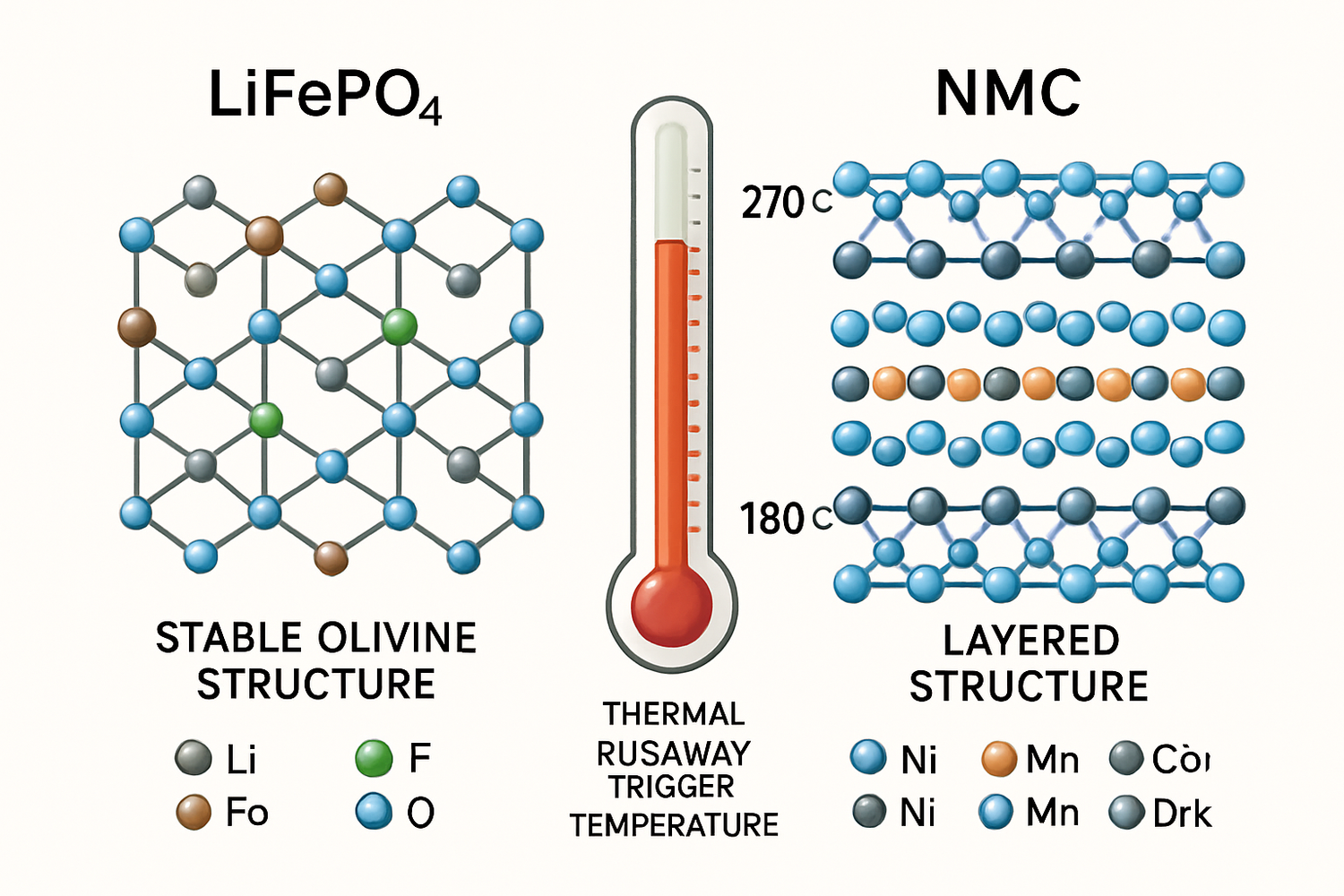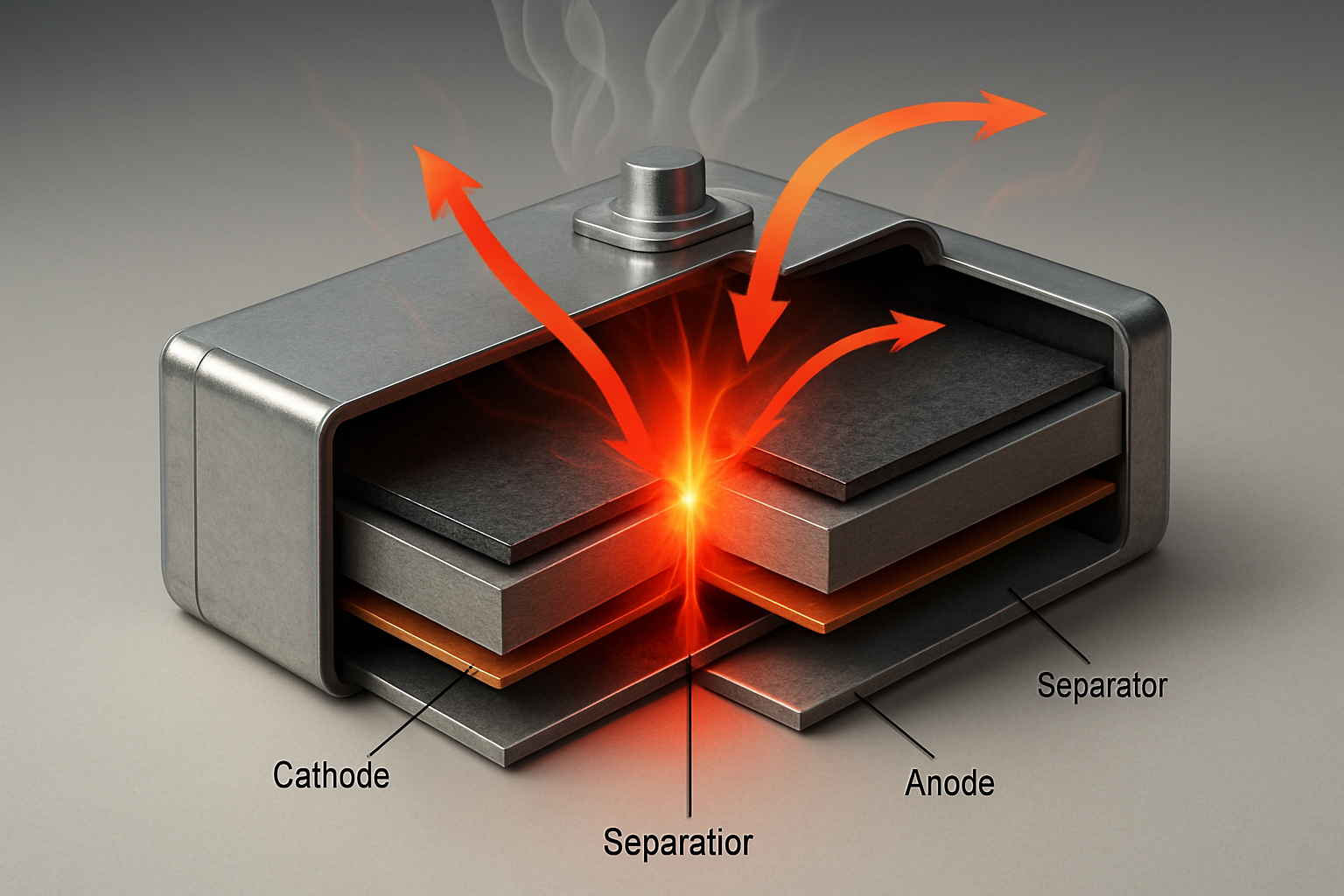Lithium-ion batteries are central to modern energy storage, from portable devices to large-scale solar systems. As this technology becomes more common in homes, safety becomes a primary consideration. Not all lithium batteries are created equal; their internal chemistry dictates their performance and, crucially, their safety profile. Among the various types, Lithium Iron Phosphate (LiFePO4) has gained significant attention for its stability. This article provides a detailed comparison of LiFePO4 fire safety against other common lithium-ion chemistries, like Nickel Manganese Cobalt (NMC).
The Chemistry of Stability: Why LiFePO4 Stands Out
The fundamental safety advantages of LiFePO4 batteries are rooted in their molecular structure. This chemistry provides a resilience that is less common in batteries with higher energy densities, directly impacting lithium battery fire safety.
A Look at the LiFePO4 Crystal Structure
LiFePO4 batteries use an olivine crystal structure, which is exceptionally stable. The phosphorus and oxygen atoms are linked by strong covalent bonds, creating a robust, three-dimensional framework. This structure resists change during charging and discharging, minimizing physical stress on the battery's components. In contrast, other chemistries like NMC and Lithium Cobalt Oxide (LCO) use a layered oxide structure. These layers can degrade over time and are more susceptible to breaking down under stress from overcharging or high temperatures. The inherent stability of the LiFePO4 structure is a key reason for its enhanced safety.
Oxygen Release: The Critical Fire Hazard
A significant risk associated with lithium-ion battery fires is a process called thermal runaway. During this event, batteries can break down and release oxygen. Since electrolytes in these batteries are flammable, the release of oxygen can create a self-sustaining and intense fire that is difficult to extinguish. LiFePO4 chemistry behaves differently. The strong phosphate-oxide bond in its structure holds onto oxygen atoms tightly, even at extreme temperatures. This resistance to releasing oxygen means LiFePO4 batteries are far less likely to fuel a fire, a critical distinction in emergency response scenarios for battery fires.
Thermal Runaway: A Comparative Analysis
Thermal runaway is an uncontrollable self-heating state that can lead to fire or explosion. The risk of this event varies significantly between different lithium chemistries, with LiFePO4 demonstrating a clear advantage.
Trigger Temperatures and Heat Generation
The temperature at which a battery begins to enter thermal runaway is a critical safety metric. LiFePO4 batteries have a much higher thermal runaway threshold, typically around 270°C (518°F). In contrast, NMC batteries can become unstable at lower temperatures, often around 210°C (410°F). This wider safety margin for LiFePO4 provides more time for a system's safety features to intervene or for users to take action if a battery begins to overheat.
| Battery Chemistry | Approximate Thermal Runaway Onset Temperature |
|---|---|
| Lithium Iron Phosphate (LiFePO4) | 270°C / 518°F |
| Nickel Manganese Cobalt (NMC) | 210°C / 410°F |
| Lithium Cobalt Oxide (LCO) | 150°C / 302°F |
The Role of the Battery Management System (BMS)
Regardless of the chemistry, a Battery Management System (BMS) is a vital component for safety. A BMS monitors cell voltage, current, and temperature to prevent overcharging, over-discharging, and overheating—conditions that can lead to lithium iron phosphate hazards or issues in any battery. While a BMS adds a critical layer of electronic protection to all battery types, it cannot alter the fundamental chemistry. The inherent stability of LiFePO4 provides a foundational safety advantage that the BMS builds upon, creating multiple layers of protection.
Real-World Implications for Home Energy Storage
For homeowners installing a solar energy storage system, the chemical composition of the batteries has direct consequences for safety, compliance, and peace of mind.
Safety Certifications and Standards
Energy storage systems are evaluated for safety by independent organizations. UL 9540 is a key safety standard for these systems, covering fire and explosion safety. The standard includes tests for the battery, inverter, and how they function together. A related test, UL 9540A, specifically evaluates thermal runaway fire propagation. Systems using LiFePO4 chemistry often meet these stringent requirements more easily due to their inherent thermal stability. Adherence to standards like UL 9540 is crucial for ensuring a safe installation that complies with local building and fire codes.
Emergency Response Considerations
In the unlikely event of a battery fire, the behavior of the battery chemistry is critical. While all lithium battery fires require a specific emergency response, the lower risk of explosive thermal runaway with LiFePO4 can make incidents more manageable. Because they are less likely to release oxygen to fuel the flames, fires involving LiFePO4 batteries may be less intense. This characteristic is a significant factor in mitigating lithium iron phosphate hazards and ensuring a safer environment.
A Balanced Perspective on Lithium Battery Selection
The choice of battery chemistry for a home energy storage system involves balancing safety, performance, and longevity. LiFePO4 batteries present a strong case, particularly for safety-conscious applications. Their key advantages—a stable crystal structure, a high thermal runaway threshold, and the absence of oxygen release during decomposition—directly reduce common fire risks. However, no battery is entirely free from risk. Quality manufacturing, professional installation, and a robust BMS are essential for any energy storage solution. For a detailed exploration of how different factors influence battery effectiveness, the Ultimate Reference for Solar Storage Performance offers valuable data. Ultimately, for residential settings where safety is a top priority, the fundamental chemical properties of LiFePO4 make it a leading choice for reliable and secure energy independence.
Frequently Asked Questions
Is LiFePO4 completely fireproof?
No battery technology is completely fireproof. LiFePO4 (Lithium Iron Phosphate) batteries have a significantly higher thermal runaway threshold and are far less likely to catch fire than other lithium-ion chemistries like NMC or LCO. Their stable chemistry prevents oxygen release, a key ingredient for fire, but improper handling, severe damage, or extreme external heat can still pose a risk.
How does LiFePO4 compare to LCO and NMC batteries in terms of fire safety?
LiFePO4 is chemically more stable. Its thermal runaway starts at a much higher temperature (around 270°C) compared to NMC (around 210°C) or LCO (around 150°C). Crucially, LiFePO4 does not release oxygen during decomposition, making it much less prone to combustion.
Does a Battery Management System (BMS) make other lithium batteries as safe as LiFePO4?
A high-quality BMS is essential for the safety of all lithium-ion batteries, as it prevents overcharging, over-discharging, and overheating. While a BMS significantly improves the safety of NMC and LCO batteries, it cannot change their underlying chemistry. LiFePO4's inherent chemical stability provides an additional, fundamental layer of safety that the BMS complements.





Leave a comment
All comments are moderated before being published.
This site is protected by hCaptcha and the hCaptcha Privacy Policy and Terms of Service apply.